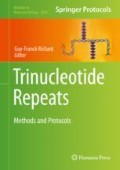Abstract
Analysis of individual gametes has a number of applications in the study of the mechanism of repeat expansion in mouse models of the fragile X-related disorders, as well as in mouse models of other repeat expansion diseases. This chapter describes the techniques required to isolate oocytes and male gametes of different stages of maturity, along with the techniques required to accurately determine the repeat number in these gametes.
Access this chapter
Tax calculation will be finalised at checkout
Purchases are for personal use only
References
Lozano R, Rosero CA, Hagerman RJ (2014) Fragile X spectrum disorders. Intractable Rare Dis Res 3(4):134–146
Lokanga RA, Senejani AG, Sweasy JB et al (2015) Heterozygosity for a hypomorphic Polbeta mutation reduces the expansion frequency in a mouse model of the fragile X-related disorders. PLoS Genet 11(4):e1005181
Lokanga RA, Zhao XN, Usdin K (2014) The mismatch repair protein MSH2 is rate limiting for repeat expansion in a fragile X premutation mouse model. Hum Mutat 35(1):129–136
Zhao X-N, Zhang Y, Wilkins K et al (2018) Mlh3 promotes while Exo1 protects against repeat expansion in mouse model for the fragile X-related disorders. PLoS Genet 14(10):e1007719
Zhao XN, Usdin K (2018) FAN1 protects against repeat expansions in a fragile X mouse model. DNA Repair (Amst) 69:1–5
Zhao XN, Lokanga R, Allette K et al (2016) A MutSbeta-dependent contribution of MutSalpha to repeat expansions in fragile X premutation mice? PLoS Genet 12(7):e1006190
Zhao XN, Usdin K (2018) Timing of expansion of fragile X premutation alleles during intergenerational transmission in a mouse model of the fragile X-related disorders. Front Genet 9:314
Zhao X-N, Gazy I, Hayward BE et al Repeat Instability in the Fragile X-related disorders: lessons from a mouse model. Brain Sci 8:E52
Hayward BE, Zhou Y, Kumari D et al (2016) A set of assays for the comprehensive analysis of FMR1 alleles in the fragile X-related disorders. J Mol Diagn 18(5):762–774
Nagy A, Gertsenstein M, Vintersten K et al (2003) Manipulating the mouse embryo: a laboratory manual. CSH Press, Woodbury
Danneman PJ, Stein S, Walshaw SO (1997) Humane and practical implications of using carbon dioxide mixed with oxygen for anesthesia or euthanasia of rats. Lab Anim Sci 47(4):376–385
Guan K, Wolf F, Becker A et al (2009) Isolation and cultivation of stem cells from adult mouse testes. Nat Protocol 4(2):143–154
Hayama T, Yamaguchi T, Kato-Itoh M et al (2016) Practical selection methods for rat and mouse round spermatids without DNA staining by flow cytometric cell sorting. Mol Reprod Dev 83(6):488–496
Entezam A, Biacsi R, Orrison B et al (2007) Regional FMRP deficits and large repeat expansions into the full mutation range in a new fragile X premutation mouse model. Gene 395(1–2):125–134
Acknowledgments
The authors would like to thank Dr. John Philip McCoy, Jr. (NHLBI) for his careful reading of the manuscript. This work was made possible with funding to KU from the Intramural Program of NIDDK, NIH (DK057808).
Author information
Authors and Affiliations
Corresponding author
Editor information
Editors and Affiliations
Rights and permissions
Copyright information
© 2020 Springer Science+Business Media, LLC, part of Springer Nature
About this protocol
Cite this protocol
Zhao, X., Lu, H., Dagur, P.K., Usdin, K. (2020). Isolation and Analysis of the CGG-Repeat Size in Male and Female Gametes from a Fragile X Mouse Model. In: Richard, GF. (eds) Trinucleotide Repeats. Methods in Molecular Biology, vol 2056. Humana, New York, NY. https://doi.org/10.1007/978-1-4939-9784-8_11
Download citation
DOI: https://doi.org/10.1007/978-1-4939-9784-8_11
Published:
Publisher Name: Humana, New York, NY
Print ISBN: 978-1-4939-9783-1
Online ISBN: 978-1-4939-9784-8
eBook Packages: Springer Protocols

